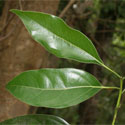|
Genus:
Cinnamomum (cinnamon, camphor genus) Life
> eukaryotes >
Archaeoplastida >
Chloroplastida
>
Charophyta > Streptophytina > Plantae (land plants)
> Tracheophyta (vascular plants) > Euphyllophyta > Lignophyta (woody plants)
> Spermatophyta (seed plants) > Angiospermae (flowering
plants) > magnoliids > Order: Laurales > Family: Lauraceae
About 250 species
worldwide (E and SE Asia through to Australia). Two species (cinnamon and
camphor) are naturalised in southern Africa and an additional three species are
cultivated.
Species naturalised in southern Africa
List from
Flora of Zimbabwe.
Cinnamomum camphora (Camphor
tree) The wood used to be distilled to
produce camphor, but this substance is now usually produced artificially.
The Camphor tree is native to East Asia (Malaysia through to Japan).
It has become naturalised in southern Africa and is a declared Category 1 invasive
plant in South Africa for the provinces of Limpopo, KwaZulu-Natal and
Mpumalanga. |
 |
Cinnamomum verum (Cinnamon bark tree, Ceylon cinnamon)
This medium-sized tree is the source of true cinnamon
and is native to Sri Lanka and India. The spice is derived from the bark
and has a sweet, spicy flavour. It is used in puddings, confectionery,
mulled wine, sauces, red meat dishes, chicken dishes, pickles and soups. The
flavour is mainly due to cinnamaldehyde, which is the main component in the
essential oil derived from cinnamon. It is cultivated in southern Africa and
has become naturalised in Zimbabwe. |
|
Cultivated species in southern Africa
List from Glen (2002).
|
Cinnamomum aromaticum (Chinese cinnamon, cassia
bark)
Not recorded in Glen (2002) but quite likely that it has
been cultivated in southern Africa. The bark is used in a similar manner to
true cinnamon bark from Cinnamomum verum.
It has a stronger flavour than true cinnamon and is cheaper so is quite
often used as a substitute for the latter. |
|
Cinnamomum burmannii
Native to India. |
|
Cinnamomum glanduliferum
Native to the Himalayas. |
|
Cinnamomum japonicum
Native to Japan, Korea and Taiwan. |
|
Publications
-
Glen, H.F. 2002. Cultivated Plants of
Southern Africa. Jacana, Johannesburg.
-
van Wyk, B.-E. 2005. Food Plants of the World -
Identification, Culinary Uses and Nutritional Value. Briza, Pretoria.
|
